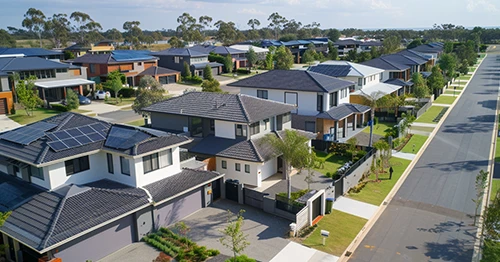Updated: 26 Dec, 2024
The national Home Value Index (HVI) rose 8.1% in 2023, recovering from a 4.9% drop in 2022, but below the 24.5% surge in 2021. December brought a soft 0.4% monthly rise in values, the smallest gain since February, indicating slowing conditions.
There was diversity in home value growth, ranging from a 15.2% surge in Perth to a 1.6% fall in regional Victoria. Growth among cities has diverged, with values rising over 1% monthly in Perth, Adelaide and Brisbane since May, while Melbourne and Sydney slowed after the June rate hike.
CoreLogic’s research director, Tim Lawless, explained, “In Perth, Adelaide and Brisbane, housing affordability challenges haven’t been as pressing relative to the larger cities, and advertised supply levels have remained persistently and substantially below average. The cities where home value growth has been lower or negative through the year are showing higher-than-average levels of advertised supply alongside annual home sales, which ended the year below the five-year average.”
Capital cities showed a stronger 9.3% growth in values versus 4.4% in regional areas, a reversal of early COVID trends as regional migration has normalised.
Property Market Highlights
- Despite the overall rise, 5 of 8 capitals remain below their record highs. These capital cities were Sydney, Melbourne, ACT, Hobart and Darwin.
- Nationally, rents were up 8.3%, down from a 9.5% rise in 2022 and a 9.6% rise in 2021.
- The annual rent growth was still over four times the pre-pandemic decade average of 2% a year.
- Growth in unit rents (10.2%) outpaced houses (7.5%) but is slowing across most unit markets.
- Slower unit rental growth may reflect slower overseas migration or could signal renters are hitting affordability ceilings.
- Perth showed the highest rental growth, with no signs of slowing. Unit rents rose 16.5% and house rents rose 12.9% in 2023.
- Hobart and Canberra had rents fall over the year.
- Regional rental growth slowed to 4.3%, the smallest annual rise since before the pandemic, which could be attributed to the normalisation of regional migration.
- Rental growth is likely to remain above average in 2024, amid tight supply. But further slowdown is possible as affordability pressures rental demand.
2024 Property Market Forecast: A Balanced View
As we look ahead to 2024, the trajectory of Australia’s property market appears to be a tale of two halves, with distinct factors shaping the landscape.
Early Challenges In Dwelling Values
The first half of the year is expected to present challenges for dwelling value growth. The impact of high interest rates and a softer economic climate is likely to test the resilience of the housing market. Signs of this were evident in late 2023, with Melbourne experiencing a decline in home values, and Sydney’s monthly growth easing to a mere 0.2%. Even Brisbane, previously showing robust growth, showed a slowdown from 1.5% in October to 1.0% in December.
Key Role Of Interest Rates
The trajectory of interest rates throughout 2024 will be a pivotal factor influencing housing trends. While the possibility of another cash rate hike cannot be ruled out, the broader trend indicates a likelihood of a decrease. A potential reduction in the cash rate target by the end of the year could stimulate demand, especially if financial markets’ predictions of a 25-basis-point rate cut by June 2024 materialise.
Policy Measures And Affordability Concerns
Government policy and affordability challenges are set to take centre-stage in 2024. Despite potential interest rate relief, policymakers are cautious about easing macroprudential policies. The Australian Prudential Regulation Authority (APRA) has maintained a three-percentage-point serviceability buffer to ensure lending quality. Housing affordability concerns are evident in metrics such as the portion of income required for rental payments at 31%, 10 years needed to save a 20% deposit, the portion of household income required to service a new mortgage is 46.2%, and the median dwelling value-to-income ratio rose to 7.5.
Supply-Side Focus And Construction Challenges
Addressing affordability challenges will likely bring a focus on supply-side measures in 2024. While there has been some relief in construction costs, the government’s ambitious goal of delivering 1.2 million new homes over the next five years remains a challenge. The Housing Australia Future Fund (HAFF) aims to support this objective, with the first round of funding expected in the latter half of the year. However, construction costs, builder profit margins, and shortages in skilled trades and materials continue to hinder the construction pipeline.
Migration’s Lagged Impact
Finally, the clear lag between overseas migration and purchasing demand is anticipated to play a role in shaping the market. With record-high migration in the previous year, the delayed impact on purchasing activity is expected to unfold in the coming years.





